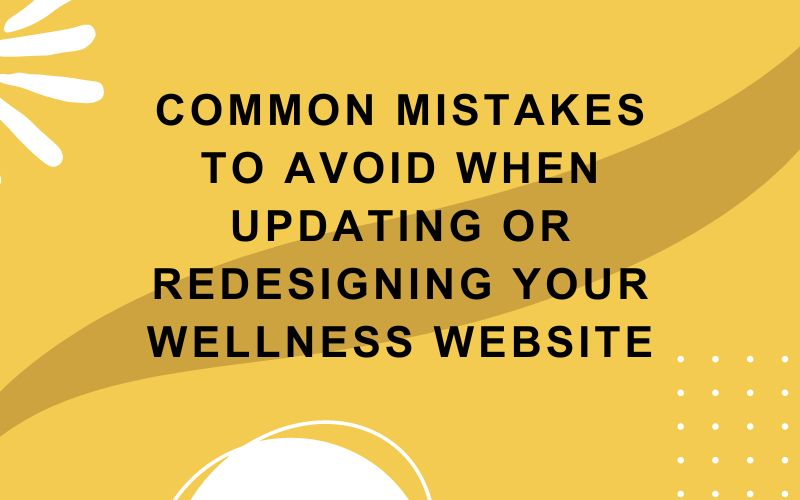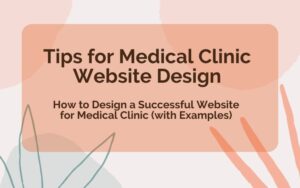A successful redesign can breathe new life into your online presence, but you must get it right. Otherwise, your website won’t attract new clients and won’t help you generate the results you’re looking to achieve.
A cluttered and disorganized website can be overwhelming for visitors, so ensure that your content is well-structured and easy to navigate.
When designing your wellness website, consider its overall aesthetic and branding. Choose colors, fonts, and images that align with your brand identity and create a cohesive and professional look.
In this article we cover some of the key points you need to consider when updating your wellness website
Understand Your Target Audience and Their Needs
Before diving into the process of updating or redesigning your wellness website, it is essential to have a clear understanding of your target audience and their needs. Take the time to research your audience demographics, interests, and preferences. This information will guide your website design decisions and help you create a website that resonates with your target market.
Consider the goals and objectives of your target audience when planning your website update or redesign. Are they looking for specific services, information, or resources? By understanding their needs, you can tailor your website content to provide valuable information and address their pain points. This will not only attract potential clients but also establish your credibility as a wellness professional.
Planning Your Website Update
Updating or redesigning a wellness website requires careful planning to ensure a smooth transition and minimize disruptions to your online presence. Start by conducting a comprehensive audit of your current website. Identify areas that need improvement, such as outdated content, broken links, or slow page load times. Make a list of the changes you want to implement and prioritize them based on their importance.
Create a detailed plan and timeline for your website update or redesign. Determine the resources and budget required for the project, and allocate them accordingly. Consider whether you have the necessary skills and knowledge to carry out the updates yourself or if you need to hire a professional web designer. Communication is key during this planning phase, so ensure that all stakeholders are involved and informed about the changes that will be made.
Make Your Website User-friendly and Easy to Navigate
One of the primary objectives of updating or redesigning your wellness website is to make it user-friendly and easy to navigate. A user-friendly website enhances the overall user experience and encourages visitors to explore your content further. To achieve this, consider the following factors:
- Responsive design: Ensure that your website is optimized for different devices and screen sizes. A responsive design will provide a seamless browsing experience for users on mobile phones, tablets, and desktops.
- Clear navigation: Implement a clear and intuitive navigation menu that allows users to easily find the information they are looking for. Use descriptive labels for your menu items and organize your content logically.
- Readable content: Use legible fonts and appropriate font sizes to ensure that your content is easy to read. Break up large blocks of text with headings, subheadings, and bullet points to improve readability.
- Fast loading speed: Optimize your website’s loading speed by compressing images, minimizing the use of plugins, and utilizing caching techniques. A fast-loading website will keep visitors engaged and prevent them from bouncing to other sites.
By prioritizing user-friendliness and ease of navigation, you can create a positive user experience that encourages visitors to stay on your website and explore the valuable content you have to offer.
Incorporate SEO Best Practices
When updating or redesigning your wellness website, it is important to consider search engine optimization (SEO) best practices. A well-optimized website will rank higher in search engine results, making it more visible to potential clients. Here are some tips for incorporating SEO into your website update or redesign:
- Keyword research: Conduct keyword research to identify the relevant keywords and phrases that your target audience uses to search for wellness services. Incorporate these keywords naturally into your website content, including headings, subheadings, and meta tags.
- Optimized meta tags: Craft compelling and keyword-rich meta titles and meta descriptions for each page of your website. These tags appear in search engine results and can influence click-through rates.
- Quality content: Create high-quality, informative, and engaging content that caters to the needs of your target audience. Search engines prioritize websites that provide valuable content to users.
- Internal and external linking: Incorporate internal links within your website to guide users to relevant pages and improve navigation. Additionally, include external links to reputable sources that support the information you provide.
By implementing these SEO best practices, you can improve your website’s visibility and attract more organic traffic from search engines.
How To Chose The Right Design & Layout
Selecting the right design and layout for your wellness website is crucial to creating a visually appealing and engaging online presence. Consider the following factors when making design decisions:
- Branding consistency: Ensure that your website design aligns with your brand identity. Use consistent colors, fonts, and imagery throughout your website to create a cohesive and professional look.
- Whitespace and visual hierarchy: Incorporate ample whitespace into your design to provide visual breathing space and prevent a cluttered appearance. Establish a clear visual hierarchy by using different font sizes, colors, and styles to emphasize important information.
- High-quality images: Use high-quality images that are relevant to your wellness services. Avoid using generic stock photos and opt for authentic and unique visuals that resonate with your target audience.
- Accessible design: Consider accessibility when designing your website. Ensure that your website is accessible to individuals with disabilities by incorporating features such as alt tags for images, descriptive captions for videos, and clear navigation for screen readers.
By carefully selecting the design elements and layout of your wellness website, you can create a visually appealing and engaging online presence that attracts and retains visitors.
Common Mistakes to Avoid
While updating or redesigning your medical website, it is essential to avoid common mistakes that can hinder its functionality and user experience. Here are some mistakes to steer clear of:
- Overcomplicating the design: Avoid cluttered and complex designs that overwhelm visitors. Keep your design clean, simple, and easy to navigate.
- Ignoring mobile optimization: With the increasing use of mobile devices, it is crucial to optimize your website for mobile users. Ignoring mobile optimization can result in a poor user experience and lower rankings in mobile search results.
- Lack of clear call-to-actions: Ensure that your website has clear and compelling call-to-action buttons that guide visitors to take the desired actions, such as booking an appointment or subscribing to your newsletter.
- Neglecting website security: Protect your website and visitors’ information by implementing proper security measures, such as SSL certificates and regular software updates.
By avoiding these common mistakes, you can create a website that functions well, provides a positive user experience, and supports your business goals.
Key Website Features To Include
When updating or redesigning your wellness website, there are key elements that you should consider to enhance its effectiveness and appeal. These elements include:
- Testimonials and reviews: Incorporate testimonials and reviews from satisfied clients to build trust and credibility. Positive feedback can help potential clients make informed decisions about your services.
- Clear service descriptions: Clearly outline your wellness services, including their benefits and outcomes. Use descriptive language to help potential clients understand how your services can meet their needs.
- Blogging and educational resources: Provide valuable content through a blog or educational resources section. This helps position you as an expert in your field and attracts visitors seeking information and advice.
- Social media integration: Include social media icons and links to your social media profiles on your website. This allows visitors to easily connect with you on various platforms and stay updated on your latest offerings.
By incorporating these key elements into your wellness website design, you can create a comprehensive and engaging online presence that appeals to your target audience.
Testing and Analysis
After updating or redesigning your wellness website, it is crucial to test its functionality and gather feedback from users. Conduct thorough testing to ensure that all website features, forms, and links are working correctly. Test your website on different devices and browsers to ensure compatibility.
Solicit feedback from your target audience and website visitors. Consider implementing surveys, feedback forms, or usability tests to gather valuable insights. Pay attention to their comments, suggestions, and pain points. Use this feedback to make further improvements and enhancements to your website.
Conclusion
Updating or redesigning your medical website is a critical step in creating a successful online presence for your business. By understanding the importance of a well-designed website, knowing your target audience, and planning your updates carefully, you can avoid common mistakes and create a user-friendly and visually appealing website.
Incorporating SEO best practices and selecting the right design and layout further enhance your website’s effectiveness. Remember to test your website thoroughly and gather feedback from users to make continuous improvements.
By following the dos and avoiding the don’ts of updating or redesigning your wellness website, you can create a website that attracts potential clients, establishes your credibility, and supports your business goals. Invest in your website, and it will be a valuable asset in promoting your wellness services.






